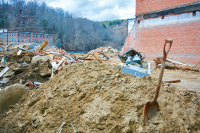Ivey’s ‘Up River’ offers valuable lessons
Up River: A Novel of Attempted Restoration by George Ivey. Dog Year, 2009. 304 Pages.
George Ivey’s Up River: A Novel of Attempted Restoration (Dog Year Publishing, ISBN 978-160844-164-8, $16.95) tells the story of Peter Bailey, a young man who, having spent his years since college working on political campaigns, wants more of a challenge in his life. He applies for, and receives, a position that entails using grant money to reverse environmental damage done to the Akwanee River in Western North Carolina.
Though the Akwanee — and the town of Walnut Flats — are both fictional, Ivey’s account of Peter Bailey’s struggles to gain a foothold in this mountain community, to win the trust of some of its people, and to carry out his mission in regard to the river ring true as a bell.
The townsfolk, both the natives and the outlanders who have settled there, are a suspicious lot, and Ivey must work hard to gain their trust. Following the advice of a few of these people — Mr. Avery, Deputy Dwight Crawford, a female river outfitter named Sandy — Bailey makes efforts to meet the farmers of the area, and introduces them to concepts like no-till cultivation. He encourages them to fight soil erosion and to devise a better way to dispose of the dead fowls and waste piling up on one of the large chicken operations in the area.
If Up River was simply a discussion of watersheds, rainbow trout, freshwater mussels, and polluting fertilizers and weed killers, the book might better have been written as nonfiction study of a real Appalachian river than as a novel. What takes this story beyond such a study, what makes it highly worthwhile in terms of the reader’s time and commitment to the book, are not the environmental digressions, which are brief, educational, and even enjoyable, but the character of Peter Bailey himself.
In Peter Bailey, Ivey has given us a character with saintly ambitions who bumbles frequently, a man who comes to the task of revitalizing a river largely ignorant of the science needed for that restoration, a fool at times in the way he approaches people. Bailey brings to mind the idealistic Pyle from Graham Greene’s The Quiet American, in which the American approaches a culture blinded by his own idealism. Though Bailey does learn a great deal living and working in Walnut Flats, we realize, as he himself eventually realizes, that he has little real idea of what he is doing. Several of his projects fail; he unwittingly offends certain members of the community; he seems to lack the ability to stick with this place — or any other place, for that matter — and has difficulty making commitments.
Related Items
This difficulty can best be seen through Bailey’s pursuit and treatment of Walnut Flats women. Though he does eventually settle on one of these women, his neighbor Melissa, whose husband is in jail for dealing drugs (Bailey helped put him there by informing on him), Bailey’s encounters with different single females reveal both his restlessness and his penchant for bumbling into situations without fully realizing where he might be led. When he is dating young Sally, for example, he tells us that “we began spending more and more time together, enjoying the easy pleasure of our relationship. I was no longer sure what had held me back with her before, and I no longer cared.” On the very next page, living through a week of November rains, Bailey reports that “the novelty of my relationship with Sally had also started washing away, all too quickly losing much of its initial shine and luster. My entire mood matched the weather.”
It is this honest portrait of Bailey that puts a stamp of originality on Up River. For here we have in a sense a sort of quintessential modern young college graduate turned politico. He has no expertise at all regarding the river, but nonetheless thinks that his people skills, which actually seem mediocre, are what is needed to revitalize its waters. He is constantly misjudging people; at one point, based on conjecture after someone steals letters on some signage in Walnut Flats, Bailey speculates that the Ku Klux Klan is active in the county. He is sometimes so blind to his own work that it isn’t until the end of the novel that he learns the meaning of the river’s name, Akwanee, and even that discovery comes by accident
Moreover, though the people with whom he works have strong family ties, Bailey is rootless — he tells Emma Lynn, who manages a convenience store, that “I guess it does seem kind of crazy to start over somewhere new. I’ve gotten used to doing that every year or two, but maybe it’s not for everybody.” He has no particular religious faith of any kind. His connections to his own family seem distant. He soft-pedals himself to women, putting himself across as a sincere and gentle man, polite, empathetic, even a trifle obsequious, but it’s basically an act. With the exception of Melissa, Bailey shows little concern in exploring the women he beds. In his own way, he’s as bad with women as Earl, Melissa’s drug-selling husband.
Yet the end of Up River brings a sort of redemption to Peter Bailey. Little of his redemption can be credited to his own efforts. Instead, the community, a benefactor, and a woman all take a hand in setting him onto a path in which he becomes a part of a family and a community rather than an outsider.
George Ivey’s Up River offers us an excellent lesson in both the reasons we should care more for our rivers and our wilderness areas, and in the human difficulties that beset that caretaking. Highly recommended.









